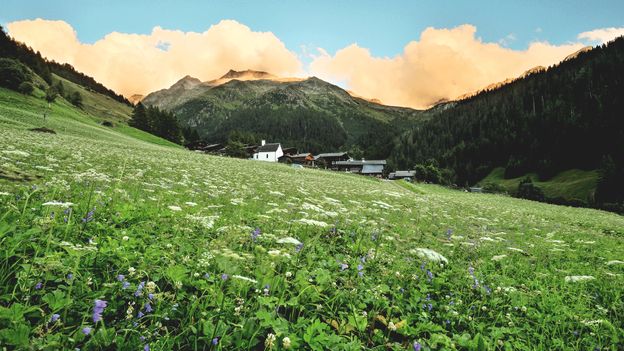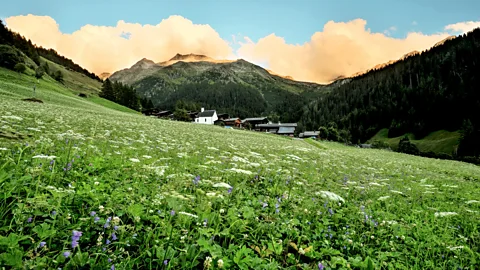 Switzerland Tourism
Switzerland TourismCrossing the High Alps through Switzerland and Italy, this 210km hiking route unravels some of the region’s most intriguing human history.
As I stopped to rest, the deep tolling of cow bells echoed across Alpine meadows bright with the blooms of wildflowers. I took in a lungful of fresh mountain air, half-wondering how on earth the Walser people managed to walk this same steep trail with their livestock and worldly possessions, and pushed further along the ancient mule track that led up and out of the Binna Valley beyond the tiny hamlet of Fald.
I was in Switzerland to tackle the first stages of the newly inaugurated 210km Walserweg Gottardo long-distance hiking trail, which officially opened in May 2024. While the natural beauty of the trail is enough to attract hikers from across the world, the route has a deeper purpose. It seeks to unravel some of the region’s most intriguing human history: the little-known story of the Walser, who migrated through the Alps from Valais to Grisons for still unknown reasons during the 12th to the 14th Centuries.
Predominantly shepherds, cattle breeders and subsistence farmers, the Walser have long been an under-appreciated part of Swiss culture. They are indigenous to the Canton of Valais in south-western Switzerland, but now mostly live at altitudes just below the High Alps, so-named because their extreme height makes permanent human habitation impossible.
The High Alps have traditionally not been celebrated but feared. The Romans, known for their military might and impressive engineering feats, called the area terra maledicta or “cursed earth”. Nevertheless, the zone immediately below the High Alps is exactly where the Walser migrated, founding small settlements further and further east on multiple occasions over many generations.
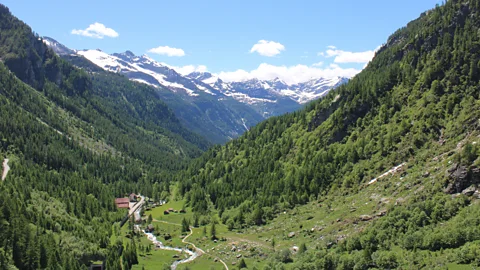 Ian Packham
Ian PackhamWhat makes the Walser’s ancient decision to migrate eastward so interesting is that the reasons behind their migrations, or Walserwanderungen, remain uncertain, even to the Walser themselves. Both overpopulation of the Upper Valais and forced migration by feudal landlords have been suggested.
“When I was in primary school [in the 1960s], they told us it was because the people had been hungry and went somewhere else where nobody lived so they were able to stay there,” Andreas Weissen, a local guidebook author told me. “Historians now say it was a programme of settlement [of previously uninhabited land].”
SLOWCOMOTION
Slowcomotion is a BBC Travel series that celebrates slow, self-propelled travel and invites readers to get outside and reconnect with the world in a safe and sustainable way.
Today there are a few thousand Walser, inhabiting around 150 individual villages mostly situated along the new trail’s route and maintaining a distinct culture and language. They speak a dialect of German largely unintelligible to Standard German speakers and live in small communities of traditional vernacular wooden “Walserhaus” homes in the remote mountains. Sometimes called “colonies”, these settlements reach all the way to Grisons, Switzerland’s easternmost canton, and as far north as Lichtenstein.
Despite their geographic spread, the Walser are aware their smallholder culture, developed through necessity due to their historic isolation, is at risk of disappearing. Many of their characteristics and traditions are intangible in nature. The Walser can’t be distinguished by their citizenship, dress, physical appearance or religious faith, meaning traditions are lost when Walser move from the Alps in search of employment or marry into non-Walser families.
“It’s just the strength to be who we are, to be different, to fight against the weather, the cold, and even be happy about it,” said Karin Tomamichel of the Walserhaus Museum, when I asked her what defines them as a people.
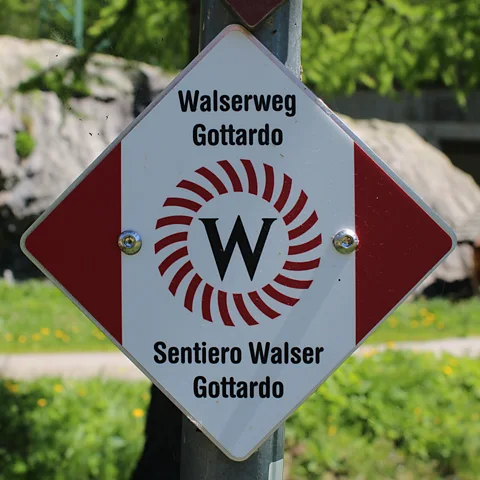 Ian Packham
Ian PackhamThe new trail, created with the full support of Walser communities, is a way of keeping the culture alive by sharing their story with a wider number of people, even as Walser populations in settlements decline.
The route starts in Valais and follows their historic migration route, linking a variety of sights and locations that help reveal the Walser’s history and culture, including villages, restaurants/bistros serving up hearty Walser cuisine and the Walserhaus Museum in the town of Bosco Gurin.
I’d decided to tackle the trail’s first five stages, which saw me cover 67km of the trail, from the Walser’s ancestral home of the village of Binn in Valais, where some Walser still live amid narrow, car-free paths that lead between chalet-style blockbau homes, recognisable by stacks of horizontal logs interconnected at the corners atop a stone cellar.
Today, Valais is known for its French-speaking majority, and while there are few physical reminders of the Walser in the canton, the historical connections can be seen in other ways. For instance, “Walser” is a contraction of the word “Walliser”, meaning “inhabitant of Valais” in the Walser German dialect of Walsertitsch, hinting at more complex linguistic and cultural origins in the canton.
From Binn, the trail makes use of the lowest pass through the mountains, the desolate 2,409m-high Albrunpass. To reach it, just as the Walser did centuries ago, I climbed steadily on ancient here-and-gone-again tracks and through pasture studded with hidden marmot burrows into larch forest spongy underfoot from endless seasons of fallen needles.
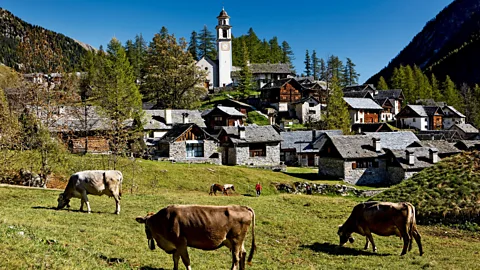 Switzerland Tourism
Switzerland TourismDuring the 20km, seven-hour ascent, I encountered only a handful of other walkers and no more than a smattering of isolated homes. Snow continued to lie knee-deep in gullies just beside the marked route and the silence of the surroundings was only broken by the occasional few bars of birdsong until I reached the relative energy of Italy’s Val Formazza, the location of the first Walser settlements south of the Alps.
Through their ongoing migrations, the Walser were the first to inhabit the region permanently, turning hunting areas and summer pasture into year-round settlements formed primary of smallholdings. Its arguably the region’s continued isolation – the Val Formazza’s village of Crampiolo still can’t be reached by road and can be cut off for months over winter due to heavy snowfall – that has helped Walser culture to survive for so long.
Walking the Walserweg Gottardo
Despite being socially conservative at heart, their migrations resulted in freedoms almost revolutionary for the period. In exchange for permanently settling the upper slopes, the Walser were able to obtain several new customary rights from landowners that most societies lacked. Called Walserrecht, they included full liberty from feudalism, the entitlement to pass inheritance on to heirs and the establishment of “mayors” elected by their communities to enforce law and order, something usually done by landlords elsewhere in Switzerland at that time. Their migrations also led to inventions such as the Rittbrätt, a forerunner of the snowboard.
Typical of the small Walser settlements I passed through was Riale, known in Walsertitsch as Chärbach. Here, I counted no more than a dozen buildings and a hilltop chapel wedded to the flat ground of the River Toce’s narrow floodplain and hemmed in by peaks still capped with snow. Each was a solidly built blockbau construction with a roof of heavy roughhewn tiles shaped from local gneiss rock.
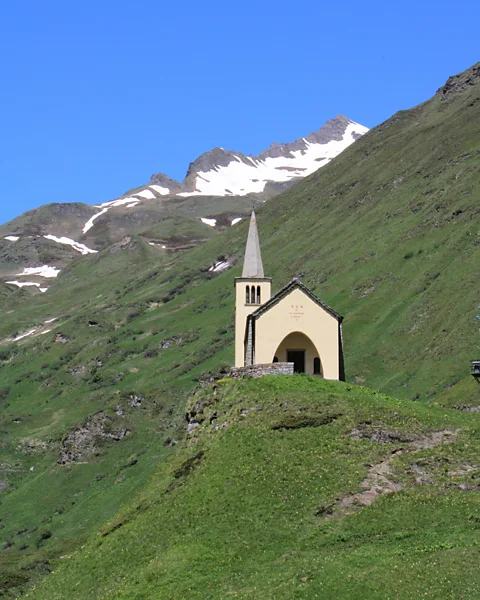 Ian Packham
Ian PackhamRiale had an almost-abandoned air so early in the hiking season, with just a couple of dog walkers and a single parked car. Even so, its two small guesthouses advertised menus packed with calorie-laden Walser specialities for energy-expending smallholders, such as Bettelmatt (a type of hard cow’s milk cheese), gnocchi Walser (potato gnocchi with bacon) and Prata Hapfla (potato pancakes). It was hard to find businesses that weren’t keeping Walser culture alive.
It was equally hard to conceive of there being any route out of valley over the mountains, given that I was hemmed in on either side with slopes seemingly too steep to tackle. Yet as early as the 13th Century, the Walser did just that, crossing the Alps to the east of Val Formazza via the Hendar Furggu Pass to found Bosco Gurin.
Their migration to the only German-speaking settlement in Switzerland’s Italian-majority canton of Ticino, is echoed by stage five of the Walserweg Gottardo.
To counter the precipitous inclines, the stage had me zigzagging from Val Formazza through shady larch forest. The trees opened out into Alpine pasture and onto the shores of Lake Superiore, reflecting nearby peaks in its still waters and sending a glacial chill through the air. Bosco Gurin’s Walserhaus ethnographic museum, housed in one of the oldest surviving structures in the Alps, dating to 1386, came into view several hours of uninterrupted walking later.
Waiting for me as I tackled the last steps of the stage along flagstones forming the village’s pedestrian-only paths, polished with generations of wear, were Tomamichel and the Walserhaus’s curator, Cristina Lessman Della Pietra, both of whom come from Walser families.
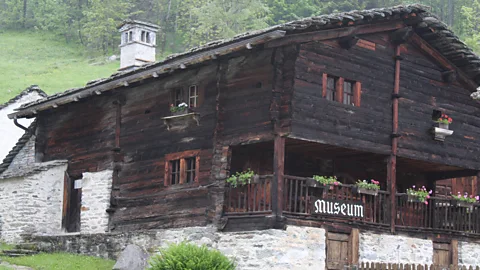 Ian Packham
Ian PackhamSpeaking with passion, their pride in their unique cultural heritage was obvious, but they were also very aware that it’s at risk of vanishing. The reason the museum was founded was to “assure Walser history by gathering everything in one place”, Lessman Della Pietra said. Founded in 1938 by an association of Walser people, its rooms are packed with everyday articles that are now anything but every day, from hand-carved cradles to an antique loom still used by a colleague of Tomamichel and Lessman Della Pietra to make cloth.
For many, it’s the language that defines the Walser, given the limited intelligibility between Walsertitsch, Swiss German speakers and Standard German speakers due to hundreds of years of the Walser’s isolated living. “The language is an aspect that is going to disappear,” warned Tomamichel. “She [Cristina] speaks it but I don’t even if I grew up here because my mum was from Ticino, from another village where they spoke Italian.”
Compounding the issue is contemporary migration, as Walser families move away from their traditional settlements to find greater opportunities in larger towns and cities. “I can imagine that many people, if they have to choose between an easy life and cultural values, they choose the easy life,” conceded Tomamichel. Where Bosco Gurin was home to 400 permanent residents in the mid-19th Century, today there are 50.
The hope is that the creation of the Walserweg Gottardo and the arrival of hikers will help maintain the Walser’s culture for years to come by providing new employment opportunities that encourage Walser people to stay. The presence of several young families, including Tomamichel’s, gives hope for the future of Walser settlements like Bosco Gurin.
“I care about my culture, my roots,” Tomamichel told me. “I grew up here and it feels natural to maintain it. The Walserweg Gottardo will help us do that.”
